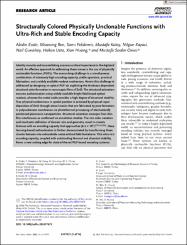| dc.contributor.author | Esidir, Abidin | |
| dc.contributor.author | Ren, Miaoning | |
| dc.contributor.author | Pekdemir, Sami | |
| dc.contributor.author | Kalay, Mustafa | |
| dc.contributor.author | Kayaci, Nilgun | |
| dc.contributor.author | Gunaltay, Nail | |
| dc.contributor.author | Usta, Hakan | |
| dc.contributor.author | Huang, Xian | |
| dc.contributor.author | Onses, Mustafa Serdar | |
| dc.date.accessioned | 2025-05-08T12:43:58Z | |
| dc.date.available | 2025-05-08T12:43:58Z | |
| dc.date.issued | 2025 | en_US |
| dc.identifier.issn | 1616-301X | |
| dc.identifier.issn | 1616-3028 | |
| dc.identifier.uri | https://doi.org/10.1002/adfm.202417673 | |
| dc.identifier.uri | https://hdl.handle.net/20.500.12573/2530 | |
| dc.description.abstract | Identity security and counterfeiting assume a critical importance in the digitized world. An effective approach to addressing these issues is the use of physically unclonable functions (PUFs). The overarching challenge is a simultaneous combination of extremely high encoding capacity, stable operation, practical fabrication, and a widely available readout mechanism. Herein this challenge is addressed by designing an optical PUF via exploiting the thickness-dependent structural color formation in nanoscopic films of ZnO. The structural coloration ensures authentication using widely available bright-field-based optical readout, whereas the metal oxide provides a high degree of structural stability. True physical randomness in spatial position is achieved by physical vapor deposition of ZnO through stencil masks that are fabricated by pore formation in polycarbonate membranes via photothermal processing of stochastically positioned plasmonic nanoparticles. Structural coloration emerges from thin film interference as confirmed via simulation studies. The rich color variation and stochastic definition of domain size and geometry result in chaotic features with an encoding capacity that approaches (6.4 x 105)(2752x2208). Deep learning-based authentication is further demonstrated by transforming these chaotic features into unbreakable codes without field limitations. This ultra-rich encoding capacity, coupled with outstanding thermal and chemical stability, forms a new cutting edge for state-of-the-art PUF-based encoding systems. | en_US |
| dc.description.sponsorship | A.E. and M.R. contributed equally to this work. The authors are grateful for the financial support of the Unit of the Scientific Research Projects of Erciyes University (FDK-2023-12660). AE acknowledges the financial support from the Scientific and Technological Research Council of Turkey (2211-C TUBITAK), X. H acknowledges the support from the Key Research and Development Program of Zhejiang Province under grant no. 2021C05005, 2021C05007-2, and the National Natural Science Foundation of China under grant no. 52121002 and 62371335. | en_US |
| dc.language.iso | eng | en_US |
| dc.publisher | WILEY-Advanced | en_US |
| dc.relation.isversionof | 10.1002/adfm.202417673 | en_US |
| dc.rights | info:eu-repo/semantics/openAccess | en_US |
| dc.subject | Anti-counterfeiting | en_US |
| dc.subject | Physically unclonable functions | en_US |
| dc.subject | Structural color | en_US |
| dc.subject | Thin films | en_US |
| dc.subject | Zinc oxide | en_US |
| dc.title | Structurally Colored Physically Unclonable Functions with Ultra-Rich and Stable Encoding Capacity | en_US |
| dc.type | article | en_US |
| dc.contributor.department | AGÜ, Mühendislik Fakültesi, Malzeme Bilimi ve Nanoteknoloji Mühendisliği Bölümü | en_US |
| dc.contributor.authorID | 0000-0002-0618-1979 | en_US |
| dc.contributor.institutionauthor | Usta, Hakan | |
| dc.identifier.volume | 35 | en_US |
| dc.identifier.issue | 12 | en_US |
| dc.identifier.startpage | 1 | en_US |
| dc.identifier.endpage | 14 | en_US |
| dc.relation.journal | ADVANCED FUNCTIONAL MATERIALS | en_US |
| dc.relation.tubitak | 2211-C | |
| dc.relation.publicationcategory | Makale - Uluslararası Hakemli Dergi - Kurum Öğretim Elemanı | en_US |


















